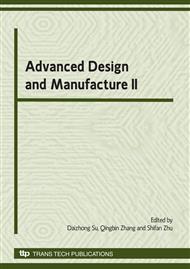p.69
p.73
p.77
p.81
p.85
p.89
p.93
p.97
p.101
Research on Multi-Actuators Speed Control Methods in Large-Scale Vessel
Abstract:
For multi-actuators speed control system driven by single pump, several effective control methods have been proposed, such as flow feedback control, etc. These methods are effective only to the engineering equipment with fewer actuators. As for large vessels with more than ten actuators required for speed control, using traditional control methods will result in that costs much, the structure of the hydraulic system is very complicated, even unable to realize. In order to meet the coordinate action of many actuators, two ways based on throttle control and pressure compensation control are introduced in this paper. The research results based on the theoretical analysis of speed control error and adaptability, simulation research and experimental confirmation indicate that the throttle control method is limited by the number of actuators, load size and the speed error, but the pressure compensation control method is helpful to enhance rationality and the coordination of flow distribution between various actuators.
Info:
Periodical:
Pages:
85-88
Citation:
Online since:
October 2009
Authors:
Price:
Сopyright:
© 2010 Trans Tech Publications Ltd. All Rights Reserved
Share:
Citation:


